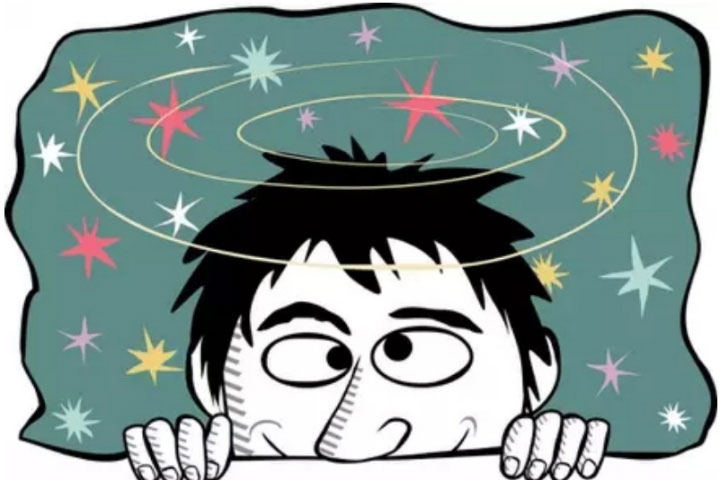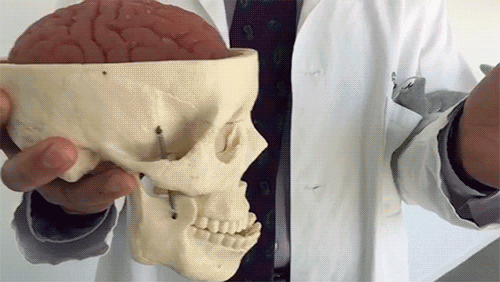Why do you find it soaring when it hits your head so hard somewhere?
The impact explodes a stream of energy, causing the brain to think that it sees a series of glittering lights that do not follow any order or shape. However, this interesting effect did not last too long.
If you have never encountered anything in your life, then you are very lucky, and it is time to step out of the nest smoothly and safely. Each of us has at least once hit an open cupboard door, tripped over, or was buried in the head with a square long wooden stick. Aside from seeing . pain and a bee-like mind, one thing only happens when we have a head injury: we will see countless stars flying.

The head impact will make you see countless stars flying.
If hit too hard, you will not see anything, but somewhere between a stunned blow and a blow that makes you unconscious personnel, the phenomenon of "flying stars" there will occur. Why?
The brain is in shock
According to ScienceABC, humans have evolved over hundreds of thousands of years to protect the most important part of our body, the brain . Human gray matter is covered by something called cerebrospinal fluid, which acts as a pillow for the brain. When you turn your head abruptly, smash your forehead against a table, or rock to your favorite song, the brain will follow the impact, but not too hard on the edges of the skull.

The brain will follow the impact, but not too hard on the edge of the skull.
However, in more severe cases, when we bang our heads at greater velocity (or when an object flies at us at high speed, something else happens.) When the fist touches our face our skull will be pushed backwards, and that is when the skull touches the front of our brain when we fall and bang our head on the ground , the skull will bend forward and its wall will touch the back of the brain - called the occipital lobe . This very fast action can disrupt the blood flow in this area of the brain and also can affect a large number of nerve cells at the back of the head.
The rapid movement of the skull and its effect on the brain is what makes us "see stars fly," because the occipital lobe is the site of the visual cortex.
Deceive visual cortex
When we open our eyes and look around, these nerve impulses are translated into images in the tissues of the visual cortex. Basically, this is how we see the world around us. However, when these tissues are violently impacted (when the skull hits the occipital lobe), the nerve cells in the back of the head release an electromagnetic pulse, which runs throughout the nerve tissue .

"Seeing stars" is a harmless effect, but anything that makes you see those stars has the potential to cause real damage to mental health.
It is this sudden release of energy that deceives our brain, making it think that it is seeing a series of sparkles of light that are not in any order or shape. This effect is not long, and when the tissues return to normal, the pressure on the nerve cells diminishes, the stars gradually disappear."Seeing stars" is a harmless effect, but anything that makes you see those stars has the potential to cause real damage to mental health.
You can create a similar experience yourself by rubbing your eyes in the morning when you wake up. By rubbing your eyes, you are exerting abnormal pressure on the optical cells behind the eye, creating a series of misleading signals on the visual cortex and forcing it to process those signals. In the same way, normal blood pressure and pressure disruption creates fake "star" images, which are basically just electrical impulses emitting randomly through your optic nerve center. .
Although lying down looking at the sky at night is a poetic hobby, having a head injury that makes you "see stars" is definitely not something to be underestimated. Protect your brain at all costs!
- New shockproof helmet
- What should you do when you hit your head hard?
- Infant's head: what mom should know!
- Hard drive hits 2 terabytes
- Unstoppable Copier - 'rescue' emergency data for damaged hard drive
- $ 25,000 prize for a lost hard drive
- The body is still alive when the first room!
- Head implant - the conquest of pioneering anatomists
- Head transplants can take place in China
- What happens when a car hits the head with a speed of 192 km / h
- Toshiba has a hard drive that automatically encrypts data
- The first head transplant surgery in history
 'Fine laughs' - Scary and painful torture in ancient times
'Fine laughs' - Scary and painful torture in ancient times The sequence of numbers 142857 of the Egyptian pyramids is known as the strangest number in the world - Why?
The sequence of numbers 142857 of the Egyptian pyramids is known as the strangest number in the world - Why? History of the iron
History of the iron What is alum?
What is alum?